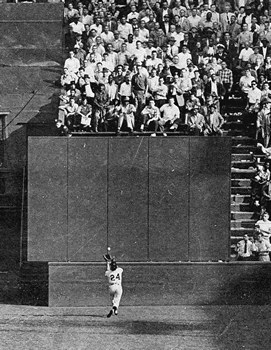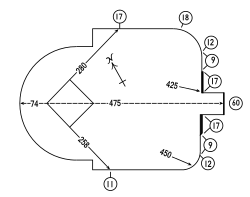The Catch (baseball)

The Catch refers to a defensive baseball play made by New York Giants center fielder Willie Mays on a ball hit by Cleveland Indians batter Vic Wertz during Game 1 of the 1954 World Series between the Giants and the Indians at the Polo Grounds in Upper Manhattan, New York City on September 29, 1954. The score was tied 2–2 in the top of the 8th inning.[1] Giants starting pitcher Sal Maglie walked Indians batter Larry Doby and then gave up a single to Al Rosen, which put runners on first and second. New York manager Leo Durocher summoned left-handed relief pitcher Don Liddle to replace Maglie and pitch to Cleveland's Wertz, also a left-handed batter.
Wertz worked the count to two balls and one strike before hitting Liddle's fourth pitch approximately 420 feet to deep center field. In many stadiums the ball would have landed out of play home run and would have given the Indians a 5–2 lead. However, the Polo Grounds was larger than average, and Mays, who was playing in shallow center field, made an on-the-run, over-the-shoulder catch on the warning track to make the out. Having caught the ball, he immediately spun and threw the ball. Doby, the runner on second, might have been able to score the go-ahead run had he tagged at the moment the ball was caught; as it was, he ran when the ball was hit, then had to scramble back to retag and only got as far as third base. (Rosen stayed at first on this play.) Liddle was then relieved by Marv Grissom, to whom he supposedly remarked "Well, I got my man!" (The next batter walked to load the bases, but the next two batters struck out to end the inning with no runs scored.)
Broadcast
Jack Brickhouse, calling the game on television for NBC, along with Russ Hodges, described Mays' catch to viewers. The audio has appeared on CD in the book And the Fans Roared, and also as accompaniment to the World Series film.

- "There's a long drive waaay back in center field...waaay baaack, baaack, it is...caaaaaught by Wil-lie Mays! [garbled – some say it sounds like "Say-Hey Mays"] [pause for crowd noise] The runner on second, Doby, is able to tag and go to third; Willie Mays just brought this crowd to its feet...with a catch...which must have been an optical illusion to a lot of people. Boy! [pause] Notice where that 483 foot mark is in center field? The ball itself...Russ, you know this ballpark better than anyone else I know...had to go about 460, didn't it?"
- "It certainly did, and I don't know how Willie did it, but he's been doing it all year."
There is some question of the depth of straight-away center field. Sometimes there was a 475 sign in center field, sometimes 483. The ballpark was demolished in 1964, and it is unclear what was being measured when. One theory (as posed in Mysteries within Green Cathedrals, a Society for American Baseball Research (SABR) article by Phil Lowry) is that the 475 was the distance to the monument and the 483 was to the clubhouse overhang. Either way, the center field corners were well under 460.
Aftermath and response
The play prevented the Indians from taking the lead and, in the bottom of the 10th, the Giants won the game on their way to sweeping the Series. The Catch is often considered to be one of the best and most memorable plays in the history of baseball because of the difficulty of the play and the importance of the game itself.[2] Some have argued that The Catch is remembered so well in part because it was made in New York City, by a player for a New York team, and on television in a World Series game, whereas other catches (including many made by Mays) were less celebrated because they came in regular season games or in other cities. Mays himself did not believe "The Catch" to be the best defensive play he ever made.[3] In the CD collection Ernie Harwell's Audio Scrapbook, issued in 2007, Mays talks about a running bare-handed catch he made at Forbes Field in Pittsburgh, Pennsylvania in 1951, in which the Giants' players teased the young rookie by treating him with complete indifference when he returned to the bench. Mays used to cite a catch he made against the center field wall at Ebbets Field in Brooklyn, New York, in which he had to scurry back so fast he did not have time to turn around. Other observers have noted that Mays' quick relay throw from deep center field was the most important part of the 1954 play, the catch itself being merely a matter of Mays outrunning the ball.
In 2006, University of Illinois at Urbana–Champaign physicist Dr. Alan Nathan argued that if the weather had been 77 °F rather than 76°, the ball would have traveled two inches farther than it did and The Catch would not have been completed (though Nathan's report does not take into account the possibility of Mays extending his reach or running a bit farther than he did). As Nathan said, "This is the ultimate proof of the old adage that 'baseball is a game of inches."[4]
See also
- Cleveland sports curse
- The Drive
- The Fumble
- The Shot
- The Decision
- The Block, a basketball play that led to the end of the alleged curse
- Babe Ruth's called shot
- Ball of the Century
- The Block (American football)
- The Catch (American football)
- The Shot (Curling)
- The Flip
- Hand of God goal
- Helmet Catch
- Immaculate Reception
- The Play
- Shot Heard 'Round the World (baseball)
- The Tackle
References
- ↑ Bahr, Chris (September 29, 2015). "Flashback: Willie Mays makes 'The Catch' in 1954 World Series". Fox Sports. Retrieved June 22, 2016.
- ↑ Axisa, Mike (September 29, 2014). "Happy 60th Anniversary: Willie Mays makes 'The Catch'". CBS Sports. Retrieved June 22, 2016.
- ↑ Morgan, Joe (May 4, 2001). "Mays was Mr. Everything". ESPN. Retrieved June 22, 2016.
- ↑ "Engineering in the News March 2007". UIUC College of Engineering. March 12, 2007. Archived from the original on September 19, 2007. Retrieved June 22, 2016.
External links
- TIME's World Series Memorable Moment #7: The Catch
- The Sporting News's 25 Greatest Moments in Baseball #9: The Catch
- The Catch on YouTube (via MLB's official YouTube channel)